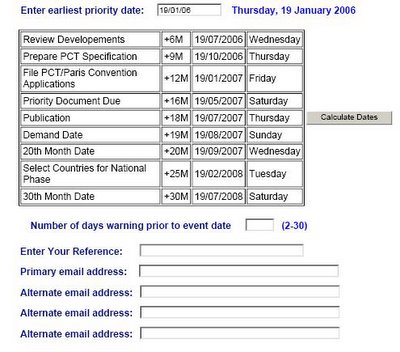(Fed. Cir.; January 9, 2006) "was careful to distance itself from the extreme language of
, which suggests that a claim may be limited to the embodiments disclosed in the specification." In his view, the dissent
(Fed. Cir. 2004), for the proposition that “[o]f course, that a patent describes only a single embodiment does not mean the claims of the patent must be construed as limited to that embodiment.”
The case involved whether the term "upstream manager" required the use of logical (rather than physical) data addressing when only logical addressing was disclosed in the specification. According to the minority opinion by Circuit Judge Dyk:
The majority [opinion by Circuit Judge Rader] relies on three theories in support of the proposition that "the [upstream manager] may route messages using either logical or physical addresses." Maj. Op., ante, at 6-7.
First, although the majority appears to recognize that there is no reference in the specification to the use of physical addresses, the majority suggests that the specification’s explicit statement that "all routing is accomplished based on logical addresses, not physical addresses" applies only to the preferred embodiment. Col. 23 ll. 1-2.
Of course, that a patent describes only a single embodiment does not mean the claims of the patent must be construed as limited to that embodiment. See, e.g.,
Liebel-Flarsheim Co. v. Medrad, Inc., 358 F.3d 898, 906 (Fed. Cir. 2004).
However, the claims will be read restrictively if the patentee has demonstrated
a clear intention to limit the claim scope. Id.; see also Teleflex, Inc. v.
Ficosa N. Am. Corp., 299 F.3d 1313, 1327 (Fed. Cir. 2002). Moreover, "the
characterization of [a limitation] as part of the ‘present invention’ is strong
evidence that the claims should not be read to encompass the , 75 F.3d 1545,
1551 (Fed.Cir.1996). opposite structure." SciMed Life Sys., Inc. v. Advanced
Cardiovascular Sys., Inc., 242 F.3d 1337, 1343 (Fed. Cir. 2001); see also Wang
Labs., Inc. v. America Online, Inc., 197 F.3d 1377, 1383 (Fed.Cir.1999); Modine
Mfg. Co. v. U.S. Int’l Trade Comm’n.
Here, the patentee clearly demonstrated that the upstream manager accomplishes routing by logical addressing. The specification characterizes the "present invention" as including the logical addressing limitation:
"[b]ecause a packet may travel through several different types of underlying networks, each with their own [physical] addressing schemes, the network protocol of the present invention defines its own independent [logical] address space. This technique hides the many different types of addresses in use for each type of data link." Col. 13 ll. 11-16 (emphasis added).
Under SciMed, the use of the term "present invention" is strong evidence that the use of logical addressing applies to the invention as a whole, not just the preferred embodiment. Moreover, as noted above, if the client could not send messages using logical addresses, the purpose of the "present invention"--to substitute logical for physical addresses--would be defeated.
Second, the majority urges that reading claim 1 to include a logical addressing limitation would "impermissibly read the ‘virtual connection’ limitation of claim 2 into claim 1, making these claims redundant." Maj. Op. at 6-7. Claim 2 recites: "The server in claim 1 wherein said connection service further creates a virtual connection between an upstream address and a downstream address for said client." Col. 25 ll. 17-20. Even assuming that logical addressing is sufficient to create a virtual connection, reading claim 1 to include logical addressing does not make the two claims redundant, because claim 1 does not contain a requirement that the connection service create a virtual connection. Claim 2 adds simply that requirement. There is thus no inconsistency in reading "upstream manager" in claim 1 to require logical addressing.
Third, the majority points out that unasserted claims 5 and 11 specifically refer to logical addresses. Maj. Op. at 6-7. In contrast, the asserted claims do not. The majority suggests that the presence of the references to logical addresses in the unasserted claims indicates that the omission of logical addresses from the asserted claims was intentional; hence, the asserted claims do not require logical addressing. Id.
In my view the majority misreads claims 5 and 11 to add the requirement that routing be accomplished by logical addressing. Id. Rather, these claims simply recite a specific means of using logical addresses that are already required by the
upstream manager. Claim 5 recites:
5. The computer-implemented method in claim 4 wherein further comprising the steps of:
receiving a service request message from said client to said server via said upstream manager, said service request corresponding to said service on said server, said service request message including said client downstream logical address and a service destination logical address;
generating a response message from said server to said client, said response message including said client downstream logical address; and
sending said response message to said client via said downstream manager. Col. 25, ll.43-55 (emphases added).
Claim 5 describes a method of handling logical addressing when a specific type of message--a service request message--is sent by the client device. It describes a situation in which the client logical address and downstream logical address are provided in the service request message, and a response is generated which includes the downstream logical address. The purpose of the claim is to claim that particular
method, not to add a requirement for logical addressing. Therefore the omission
of the term "logical address" from the asserted claims does not reflect the
claimant’s intent that logical addressing not be part of those claims. The same
analysis applies to Claim 11, which rewrites Claim 4 in means-plus-function
form.
In my view the upstream manager includes a requirement that the upstream manager route messages using logical addresses. Because nCube presented no evidence that the alleged upstream manager in the accused device uses logical
addresses to send messages to any service on the server, I would reverse the
verdict of infringement. I thus would not reach the question--addressed by the
majority--whether all client communications must be routed through the upstream
manager.

























